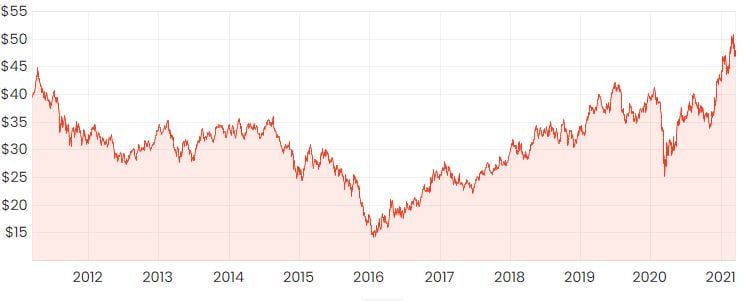If you were to ask someone which “blue chip” shares are most commonly found in an average mum-and-dad ASX share portfolio, you’d probably hear names such as Commonwealth Bank of Australia (ASX: CBA), perhaps CSL Limited (ASX: CSL) and Wesfarmers Ltd (ASX: WES).
BHP Group (ASX: BHP) shares would also be a popular choice, as they’re often seen as safe, reliable and a great long-term investment.
The share price chart below would indicate that depending on when you’ve held BHP shares, you could’ve done quite well on your investment, or perhaps the opposite.
BHP share price

Why are BHP shares so volatile?
BHP falls into the category of a price-taker, meaning it has little control over the price it can charge for the commodities it produces. Instead, it must accept the market price which is influenced by supply and demand factors.
Due to fluctuations in commodity prices, which influences profitability and therefore the share price, your decision to invest today would partly be based on your prediction of future commodities prices.
Rather than adopting a “buy and hold” approach for BHP’s shares, it’s quite common to treat this sort of investment as a shorter-term trade used to ride the upside of a commodities cycle, and then exit when the company’s outlook changes.
This is a perfectly valid investing strategy, but if you’re not looking to actively trade stocks based on future predictions, BHP might not be the most appropriate addition to your portfolio.
What’s better than a price-taker?
If my investment horizon was long, I’d rather invest in companies that have the ability to consistently raise prices over time.
The ideal sort of business would be a price-maker, rather than a price-taker. As you can probably guess, a price-maker is the complete opposite and has the ability to dictate the market price.
An example of a price-taker would be a company that has a monopoly over a particular market, where its buyers have no alternative competitors.
What’s more common though are businesses that offer such an attractive product or service where customers are willing to pay a premium price.
Xero
I think cloud-based software provider Xero Limited (ASX: XRO) is a good example of a company that has a fairly high degree of pricing power.

Xero has the ability to attract developers who can build third-party apps, which can be integrated into Xero’s platform. As the ecosystem grows, it attracts more developers which improve the ecosystem even further, and the cycle continues.
This is just one example of why I think Xero’s business model is almost too good to be true. It’s also why I think Xero’s customers would be willing to keep their monthly subscription even if a small price hike was to occur.
Valuing a business like Xero is much different from how you’d typically look at a commodities producer. The video below explains some of the metrics involved.
https://education.rask.com.au/2020/02/12/saas-valuation-multiples-video-explainer-example/
Even just a small increase in the monthly fee would have such a leveraged effect on revenue, so I think there may be some untapped pricing power once the business matures out further.
If you’d like to read more on Xero, click here to read: Down 28% in 3 months: Are Xero (ASX:XRO) shares in bargain territory?
I’d also recommend signing up for a free Rask account which gives you access to our stock reports.









